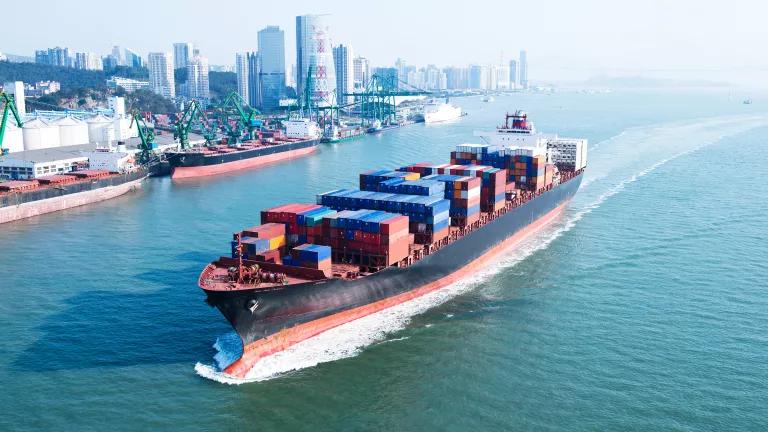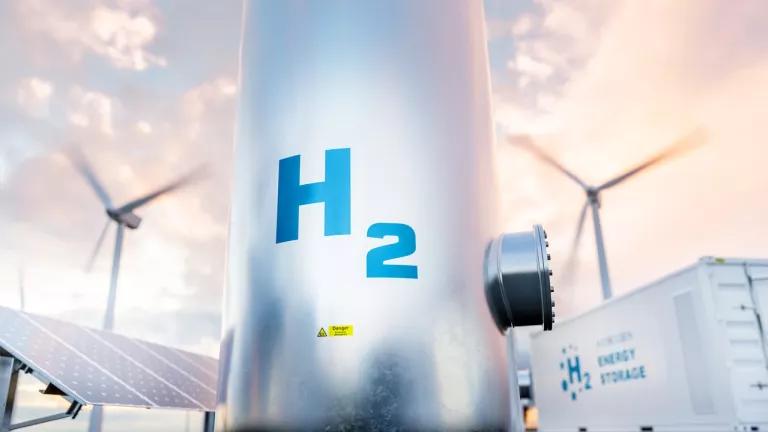International Trade: A Policy Tool for Climate Action?
Recently introduced Democrat and Republican bills propose tariffs at the border for widely traded products with high greenhouse gas emissions intensity.

Many carbon-intensive materials are traded heavily across borders.
Shutterstock
Through the ongoing implementation of the historic climate programs from the Bipartisan Infrastructure Law (BIL) and the Inflation Reduction Act (IRA), the United States is starting to take serious action to curb greenhouse gas emissions (GHG) from a long-overlooked leading source: the production of industrial materials like cement, steel, and aluminum. Domestic investment in decarbonization of industry is crucial but it will seldom be enough. Industrial materials are traded on the global market, so we need smart trade policy centered on carbon pollution to help move the needle on emissions from heavy industry.
One promising solution is a carbon border fee, which is gaining traction among U.S. policy makers. In a welcome show of bipartisan alignment in Congress, Republican and Democratic legislators have each recently introduced bills that would place a fee on imported products based on their emissions intensity. On November 3rd, Senators Bill Cassidy (R-LA) and Lindsay Graham (R-SC) introduced the Foreign Pollution Fee Act. Then this week, Senator Sheldon Whitehouse (D-RI) and Representative Suzan DelBene (D-WA) reintroduced the Clean Competition Act (cosponsored by Senators Brian Schatz (D-HI) and Martin Heinrich (D-NM), and Representatives Don Beyer (D-VA), Kathy Castor (D-FL), and Ami Bera, M.D. (D-CA)).
Both proposals effectively call for a carbon border fee that would apply to globally traded commodities including energy-intensive and trade-exposed industrial materials such as iron and steel, aluminum, and cement, whose production accounts for 7 percent, 2 percent, and 8 percent of global CO2 emissions, respectively. Under a carbon border fee, dirtier products would be subject to higher tariffs when imported into the United States—spurring a global race to the top by treating climate action as an asset as opposed to a liability.
While both the Republican and Democratic proposals incorporate carbon pollution into U.S. trade policy, the nuts and bolts of the two bills vary and much work lies ahead to potentially converge on a single proposal. With the proposals out of the gate, let’s take a step back and describe how a well-designed carbon border fee could support climate action and U.S. competitiveness.
What is a carbon border fee?
A carbon border fee—also sometimes referred to as a carbon border adjustment mechanism (CBAM) or a border carbon adjustment (BCA)—is essentially a tariff imposed on imported products proportional to their emissions intensity. So if an imported product has been produced at a relatively high-polluting industrial facility, it would be subject to a tariff at the U.S. border. In this manner, a carbon border fee serves as a pollution penalty that puts dirtier products on more equal footing with cleaner alternatives and helps ensure that cheap-but-dirty production methods are not a comparative market advantage. Imported products that are cleaner than their domestic counterparts will not be subject to the carbon border fee.
What are the benefits of a carbon border fee?
There are good reasons that policy makers in the United States would want to put a carbon border fee in place. Through the BIL and the IRA, Congress and the Biden administration approved billions in federal investments to spur the innovation and deployment of industrial decarbonization solutions that can create jobs and revitalize the domestic manufacturing sector.
And the need is great. Industry is responsible for 30 percent of U.S. economy-wide GHG emissions. Globally, the proportion of GHG emissions from industry is even larger. Certain global scenarios project that by midcentury, GHG emissions from the industrial sector will exceed all emissions from power, transportation, and buildings combined, absent interventions. If we want to meet our climate goals, the United States and governments around the world that are committed to climate action must immediately enact policies aimed at decarbonizing the industrial sector. And since this is a trade-exposed sector, climate considerations must become an integral component of trade policy to avoid having cleaner products undercut by cheaper-but-dirtier alternatives.
A carbon border fee can ensure that ongoing investments in the innovation and deployment of climate technologies bear fruit domestically and guide the global market toward climate success:
- Encourage greater climate ambition globally. By charging import tariffs commensurate to the carbon intensity of products, countries and companies have an incentive to decarbonize in order to avoid financial penalties and to gain greater access to the U.S market. Similarly, U.S.-based companies also have an incentive to further decarbonize because the tariffs levied on imported products would likely be based on the difference in emissions intensity between those imported products and comparable domestically-produced products. So, to the extent that U.S. companies reduce GHG emissions, that delta will increase and so will the import tariffs. This encourages a race to the top in climate action.
- Protect U.S. investment in decarbonization. Spurred by incentives in the BIL and the IRA, U.S. industry has been investing unprecedented amounts of private capital into carbon pollution reduction technologies. But those same products are competing in the market with imported products, at times originating from facilities that do not adhere to climate and environmental standards and/or that have not invested in reducing their carbon footprint. A carbon border fee would impose costs on those imported products to partially compensate for shortchanging global welfare (i.e., through generating undue GHG pollution).
Should a carbon border fee treat all countries equally?
While a tariff on dirtier products produced abroad is important for climate action, it is also critical that a carbon border fee policy be designed in a way that does not disproportionately disadvantage low and middle income developing economies which have contributed the least to the climate crisis, such as Least Developed Countries (LDCs) which the United Nations characterizes as “highly vulnerable to economic and environmental shocks.”
Given that products originating from LDCs account for a negligible fraction of U.S. imports, policy makers could consider carefully crafted exemptions for LDCs as part of any carbon border fee. Unconditional exemptions however run the risk of leading to resource shuffling from carbon-border-fee-regulated countries to exempt countries, so guardrails should be put in place to avoid creating compliance loopholes. For example, a carbon border fee may be designed to exempt only a certain quantity of imports from LDCs or other exempt countries to avoid a regulated country using an exempt one as a pass-through for exports or allow for minimal final processing in an exempt country in order to skirt the import tariffs—both of which would undermine a carbon border fee while leading to little to no benefit for the exempt countries.
But more than just avoiding further harm to low and middle income developing countries, we also do not want to leave them behind as the rest of the world decarbonizes. As such, a carbon border fee policy can be designed to channel financial and technical support to assist others in decarbonization and low-carbon development.
What comes next?
Both the Republican and Democratic bills represent a major step forward toward a critical policy that would incentivize climate action globally while protecting domestic jobs and rewarding domestic producers for the efforts they have already taken to clean up their industries. This is commonsense good policy, which is why other countries around the world are seriously considering adopting a carbon border fee (the European Union just launched its own).
While we are encouraged to see movement on a carbon border fee in the United States, the conversations are still at a nascent stage in Washington. We urge Members of Congress to soon begin negotiations on how to reconcile the two introduced bills so that the United States can advance climate-forward and equitable trade policy.





